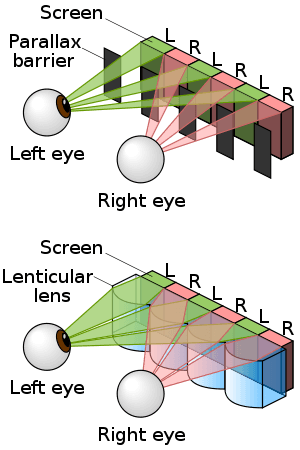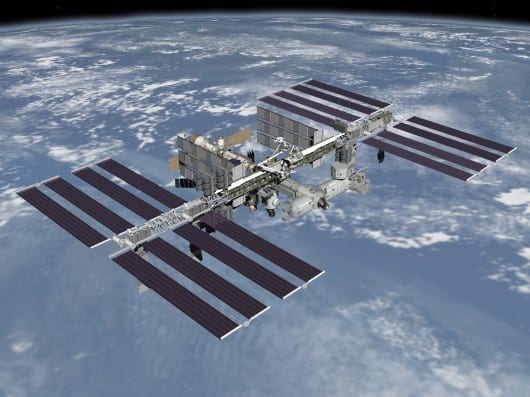
Temasek Polytechnic (TP) and A*A*STAR’s Institute of Materials Research and Engineering’s (IMRE) new nano-engineered screen protector that turns the ordinary screens of handheld devices into 3D displays will be marketed by start-up, Nanoveu Pte Ltd. The unique plastic film can also potentially be used as next generation security tokens employed by banks and corporations.
1. Singapore, 02 April 2013 – Ditch the 3D glasses. Thanks to a simple plastic filter, mobile device users can now view unprecedented, distortion-free, brilliant 3D content with the naked eye. This latest innovation from TP and IMRE is the first ever glasses-free 3D accessory that can display content in both portrait and landscape mode, and measures less than 0.1 mm in thickness.
2. “The filter is essentially a piece of plastic film with about half a million perfectly shaped lenses engineered onto its surface using IMRE’s proprietary nanoimprinting technology,” said Dr Jaslyn Law, the IMRE scientist who worked with TP on the nanoimprinting R&D since 2010 to enhance the film’s smoothness, clarity and transparency compared to other films in the market.
3. To complement the filter, the team developed applications for two software platforms, Apple iOS and Android, which allow users to play 3D content through its filter, in both landscape and portrait formats. The applications also allow 2D pictures taken using mobile devices to be converted into 3D. The team will be releasing a software development kit that enables game developers to convert their existing games into 3D versions.
4. The team is also exploring using the same technology for security access tokens to decode PIN numbers sent online as an inexpensive and portable alternative to rival bulkier and more expensive battery-operated security tokens, similar to those used by Singapore banks today.
5. “The team’s expertise in both hardware and software development in 3D technology has enabled high quality 3D to be readily available to consumers,” said Mr Frank Chan, the TP scientist who led the overall NRF-funded project. “We have taken age old lenticular lens technology that has been around for the last hundred years, modernised it and patented it using nanotechnology.” Lenticular lens technology creates a transparent film that retains the brilliance of 3D visuals and effects, which does away with the need for stronger back lighting and saves on battery consumption in mobile devices.
The Latest Bing News on:
3D display
- Mapping the Milky Way's magnetic field in 3Don April 27, 2024 at 10:51 am
We are all very familiar with the concept of the Earth's magnetic field. It turns out that most objects in space have magnetic fields but it's quite tricky to measure them. Astronomers have developed ...
- Swave Photonics develops true holographic display for spatial computingon April 25, 2024 at 1:00 pm
Swave Photonics, a "true holographic display" company, announced the world’s first 3D holographic display technology for XR.
- Swave Photonics debuts Holographic eXtended Reality display with tiny-pixel technologyon April 25, 2024 at 6:00 am
Holographic display startup Swave Photonics today announced the development of what is claimed to be the world’s first 3D holographic display technology for compact extended reality form factors such ...
- Ulysse Nardin Unveils $148,300 Freak S Nomad Watch In High-Tech 3Don April 24, 2024 at 1:05 pm
The new Ulysse Nardin Freak S Nomad boasts colors that recall the desert dunes and a high-tech movement that is devoid of hands, crown, dial and more.
- oOh!media unveils Perth's first 3D anamorphic displayon April 23, 2024 at 3:43 pm
D Anamorphic out-of-home has made its debut in Perth, with oOh!media launching at its Yagan Square site, with creative and innovation hub POLY partnering with Scitech for the inaugural campaign. ...
- Innolux to showcase GenAI 3D printing; Other versatile display solutionson April 22, 2024 at 8:29 pm
Innolux will showcase its Generative AI (GenAI) technologies at the 2024 Touch Taiwan, including a 3D printer with AI 3D imaging solutions and its "Chat-N-Go" AI Automated Guided Vehicle (AGV) display ...
- How to turn off Google Maps 3D buildings on Android Auto and CarPlayon April 20, 2024 at 9:15 am
Google Maps on Android Auto and CarPlay now features the ability to show 3D buildings and it's on by default, but here's how to turn it off.
- Formlabs launches Form 4 3D printer for prototyping to productionon April 17, 2024 at 1:01 pm
Formlabs announced the launch of its Form 4 and Form 4B 3D printers to help professionals go from prototype to production.
- The redesigned 3D printer from Formlabs gets us one step closer to the Enterprise Replicatoron April 17, 2024 at 6:23 am
The Form 4 is modular, more precise, and five times faster than the previous generation. The Form 4 3D printer is modular, more precise, and five times faster than the previous generation.
- Firearms cheaply made on 3D printers, guns pouring into NJ from Pa; lawmakers seek solutionson April 16, 2024 at 3:17 pm
Lawmakers in New Jersey say something needs to be done about illegal guns in the Garden State. Many of the guns are being printed at home on 3D printers, while others are flowing from Pennsylvania.
The Latest Google Headlines on:
3D display
[google_news title=”” keyword=”3D display” num_posts=”10″ blurb_length=”0″ show_thumb=”left”] [/vc_column_text]The Latest Bing News on:
3-D display
- I’m a Car Expert: Here are 3 Reasons I’d Never Buy a Used Car From a Dealershipon April 27, 2024 at 3:00 pm
If you do your research and find one that will last for a while, you can budget for regular maintenance with relative confidence that ...
- Rare, unique vehicles on display at fairgroundson April 27, 2024 at 3:00 pm
Whether it’s a Studebaker or a station wagon, the vehicle has meaning to its owner, who has probably invested plenty in that prized possession.
- When You Like Your Dog More Than Your Partneron April 27, 2024 at 8:59 am
You like the dog more than me.” As absurd as this accusation sounds, it’s one that gets leveled in almost all romantic relationships that involve cohabitating with pets. Iv ...
- Massive Best Buy weekend sale is live — here’s 21 deals I’d get on OLED TVs, headphones, laptops and moreon April 27, 2024 at 8:26 am
Asus Vivobook 14: was $429 now $249 @ Best Buy The Asus Vivobook 14 is a solid laptop for shoppers on a budget. It comes with an Intel Core i3-1215U processor, 8GB RAM and a 128GB SSD. It also has a ...
- Jay Williams slams D'Angelo Russell for being on his phone during team huddle: "I don't want him on my roster"on April 27, 2024 at 12:45 am
D'Angelo Russell 'disengaged' himself from the Lakers when he refused to join a team huddle late in the 4th quarter of Game 3.
- Schwarber and Harper lead Phillies' power display in 9-3 victory over the Padreson April 26, 2024 at 9:26 pm
Kyle Schwarber homered on Joe Musgrove's fourth pitch and Bryce Harper also had one of the Philadelphia Phillies' five home runs in a 9-3 victory over ...
- Inaugural Katie Acts to display the eclectic talents of St. Kate’s communityon April 26, 2024 at 2:47 pm
Palleja’s was the very first act received when submissions opened last year, and the origins of her ocarina talent sparked an idea for Katie Acts director Shanan Custer ’92, herself a St. Kate’s alum.
- Lakers' D'Angelo Russell destroyed for freezing cold take, Game 3 bench anticson April 26, 2024 at 10:02 am
Lakers guard D'Angelo Russell is being torn to shreds for looking disinterested on bench after brutal Game 3 showing ...
- Applegate Skate Park mural now on display in Mercedon April 26, 2024 at 6:37 am
The project is meant to serve as a platform for storytelling and showcase Merced's unique identity.
- Iconic Smokey Bear artwork to be on display at Smokey Bear Historical Parkon April 25, 2024 at 5:00 pm
Full Story: https://www.krqe.com/news/new-mexico/iconic-smokey-bear-artwork-to-be-on-display-at-smokey-bear-historical-park Which new uniforms are winners this season?
The Latest Google Headlines on:
3-D display
[google_news title=”” keyword=”3-D display” num_posts=”10″ blurb_length=”0″ show_thumb=”left”]










